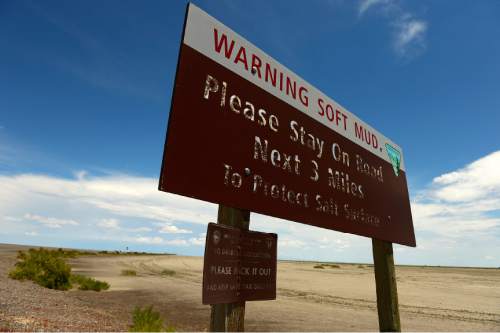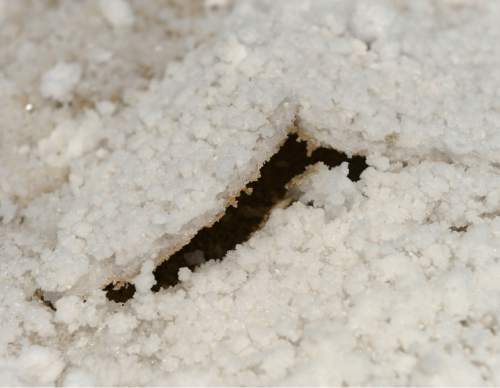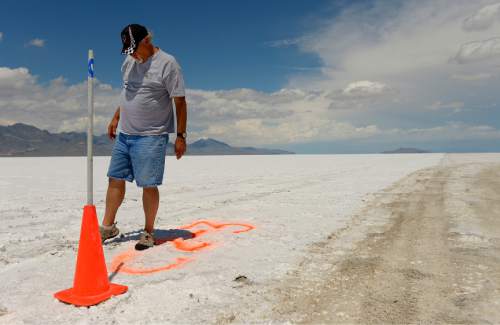This is an archived article that was published on sltrib.com in 2015, and information in the article may be outdated. It is provided only for personal research purposes and may not be reprinted.
An investigation this week confirms that portions of the Bonneville Salt Flats' upper crust are thin or completely dissolved, jeopardizing next month's Speed Week, the Bureau of Land Management said Friday.
The BLM did not order the hundreds of high-speed auto racers from throughout the world to stay away. But the agency said in a news release that if the thickness of the salt does not increase soon — presumably by evaporation — "it will likely limit racing opportunities on the Bonneville Salt Flats this year to the shorter track area with good surface salt."
The BLM sent two professional geologists, a university expert and an outdoor recreation planner to the salt flats Wednesday because racing enthusiasts are worried that Speed Week, due to begin Aug. 8, may have to be canceled for the second straight year.
The Utah Salt Flats Racing Association has already canceled one event, the Test 'n' Tune meet.
Experts from the BLM found some areas where the upper crust is thick and healthy, and able to support high-speed racing and other recreation.
But in some portions of the area generally converted into race tracks during Speed Week, the salt is extremely thin or missing entirely, exposing the muddy gypsum layer below.
The Southern California Timing Association has said it will make an official announcement about Speed Week by July 22. The group is asking racers, via its website and social media, whether they would still attend if they were limited to a shorter course or two.
A typical Speed Week involves courses of different lengths: 9-mile courses for the fastest racers who want to push 400 to 500 mph, slightly shorter courses for those going 300 mph, 3-mile courses for 200 mph runs, and a "mini" 2-mile course.
The possibility that Speed Week will be canceled, again, infuriates the racing community, especially those who have spent money and begun to travel from around the globe. Many are dubious of the BLM's claims that the declining salt is mostly due to weather; some speculate that mineral mining in the region is robbing the flats of their salt.
In its Friday news release, the BLM noted that it is asking the University of Utah to study the salt flats. Understanding the variables that affect the flats "is a key to unlocking any direct methods to increase surface salt layers and racing opportunities," the release said.
This year's marked decline in the salt flats' condition appears to be caused by pools of water that dissolved the upper crust, the BLM said.
The causes "will require more research to understand and possibly mitigate."
Kevin Oliver, manager of the BLM West Desert District that oversees the Bonneville Salt Flats, said the flats' condition varies with the weather. "It is a dynamic situation," he said in an interview.
Oliver said he has received several emails and other messages from disgruntled racers, and some on social media are suggesting a class action lawsuit against the BLM or pressure on political figures to take action.
The BLM has tried to keep the salt flats from shrinking in the past.
In 1997, in response to studies in the 1960s and 1970s showing the salt flats were shrinking, the BLM and two mineral extraction companies agreed to a five-year experiment to pump tons of salty water back out onto the salt flats. That didn't really help, follow-up studies showed.
Research by retired BLM geologist Bill White suggested that while pumping may not add salt to the crust itself, increasing the salinity of the brine below the salt flats may contribute to the chemical stability of the overall system.
That led the BLM to require mining company Intrepid Potash, in its 2012 permit, to continue laying down salt. It's the only company required to pump salt back to the flats.
This past winter alone, Oliver said, Intrepid pumped 583,000 tons of brine onto the salt flats. Oliver said the BLM regularly inspects the salt laydown system to ensure everything is working properly.
"We don't just depend on trust," he said. "That's our responsibility."













